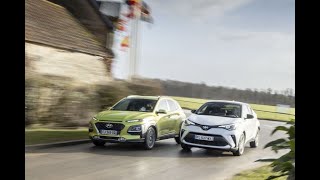
Hyundai Kona vs Toyota C-HR
The #Kona's stand-out design is reinforced by the car's voluminous, aggressive body styling, that emphasizes the car's well-proportioned, dynamic silhouette. Its low and wide stance complements the car's stylish profile, with the long wheel base and short overhangs ensuring sporty, nimble handling, in addition to delivering superior driving stability at high speed.
A 2.0-liter MPI Atkinson engine produces 149PS, with a 0-100km/h time of 10 seconds and a top speed of 194km/h. Paired with a six-speed automatic transmission, the engine delivers maximum torque of 179 NM (13.8 kgf · m) at 4500rpm.
The Gamma 1.6T-GDI engine boasts 177PS, a 0-100km/h time of 7.7 seconds and a top speed of 210km/h. The engine delivers maximum torque of 265NM (27kgf · m) from 1,500 to 4,500rpm and is mated to Hyundai's efficient and responsive seven-speed dual-clutch transmission (7DCT).
In addition to the 1.6T-GDI engine, customers in Europe can also opt for #Hyundai's downsized 1.0 T-GDI turbocharged three-cylinder engine with six-speed manual transmission. This turbo-charged powerplant is optimized for efficiency and produces 120PS, a 0-100km/h time of 12 seconds, top speed of 181km/h and maximum torque of 172NM (17.5kgf · m) from 1,500 to 4000 rpm.
The all-new #Toyota C-HR introduces a distinctive styling that brings newfound dynamism and sensuality to the crossover market, combining a coupe-like upper body with the powerful underpinnings of an SUV.
4,360 mm long, 1,795 mm wide, 1,555 mm high (Hybrid) and with a 2,640 mm wheelbase, the production vehicle remains remarkably true to the concept car's exterior which was first shown at the Paris Motorshow in 2014, and which registered extremely well with target customers.
Fitted with the latest-generation hybrid power plant, the Toyota C-HR generates CO2 emissions as low as 82 g/km - a figure unrivalled within its segment - and returns combined fuel consumption of only 3.6 l/100 km.
Delivering 90 kW/122 DIN hp, this new hybrid powertrain is not only more efficient and lighter than the previous system, but also offers sharper performance. Detailed design changes to the engine have resulted in a thermal efficiency of 40% - a world-beating performance for a petrol unit.
Description: https://www.youtube.com/c/NCMEpicMusic Inspiration: Composed By Ender Güney
























